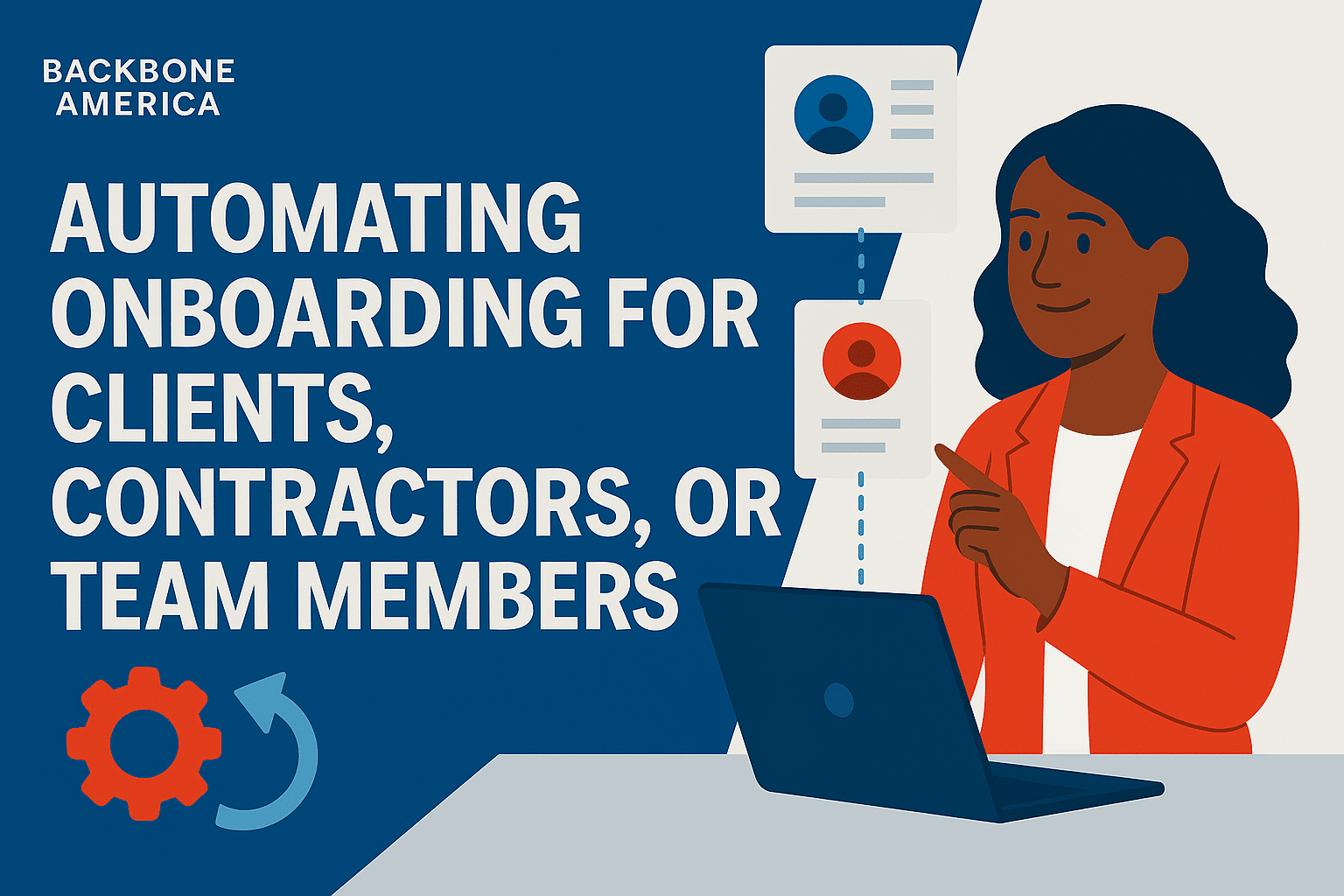Workflow Wednesday

That doesn’t mean handing everything to a VA or buying a new app. Automation isn’t just delegation or digitization. It’s the deliberate design of systems that run without you—so your energy can focus on higher-level decisions, strategy, or even just a breather.
I’ll be real with you: for a while, I thought I had this automation thing down. I had tools in place. I had team members. I had workflows—or so I thought. But the truth hit me hard one week when I sat down to plan content and realized I still felt like I was running everything by hand. Every. Single. Thing.
That’s when I knew something wasn’t working. And the answer wasn’t “just hire more help.” It was to actually automate repetitive tasks—the kind of automation that doesn’t just move faster, but moves without me.
Why It Still Feels Manual (Even When It Shouldn’t)

Delegation without structure? That’s a mess wrapped in good intentions. If your team still needs you to assign every task, check every draft, or follow up on what should already be done—you haven’t built a system. You’ve just outsourced your mental load. And that load doesn’t get lighter when you’re still the glue. It just stretches your energy thinner.
Even automation can be deceiving. It might look good on paper—a few automated emails here, a CRM tag there—but if you still have to jump in to push things along, it’s not doing the job.
I ran into this exact problem. I hired people hoping the work would just get done—cleanly, consistently, without me needing to be in the loop. Instead, I was constantly pulled back in: approving, checking, clarifying. The automations I had? They weren’t real automations. They were pseudo-systems that still needed me to trigger or verify parts manually. That sucked up the time I needed for the things that would actually move my business forward.
What Real Automation Looks Like (And How to Spot It in Your Own Business)
Before you start automating, it helps to know what real automation looks like. It’s not just setting reminders or sending templated emails. True automation removes you from the process entirely—so things get done without your intervention, your approval, or your memory.
Here are a few ways automation might show up in your business when it’s working well:
A lead form automatically tags and segments responses in your CRM based on their answers—no manual sorting.
A new buyer gets their onboarding emails and digital access instantly, without you lifting a finger.
Discount codes are triggered and customized automatically based on actions users take or fields they fill.

In my case, the Business Launch Assessment does this through Zoho Flow. When someone completes it, their score determines how they’re segmented and what emails they get—no manual tagging. Similarly, the 31-Day Startup Challenge runs on a fully automated delivery schedule. I don’t have to check in daily. That’s the kind of system that allows me to step away and still keep things moving.
If that’s not where your systems are yet, don’t worry. Use these examples as a benchmark—not for perfection, but for possibility.
Where Your Time Might Still Be Getting Eaten Alive
Even if you’ve delegated and set up a few automations, you might still find yourself doing more than you
Here’s what that might look like:
You’re reviewing routine work that should already meet your standards
You’re going back and forth with team members for approvals or handoffs
You’re following up on tasks that should happen automatically
You’re stuck in limbo—waiting for something to be “done” so you can do your part
That was my situation. I wasn’t reviewing every detail—once my team understood what I wanted, I didn’t need to check their work anymore. But the workflow itself was still clunky. We were constantly sending messages like, “This part’s ready—your turn,” or “Let me know when you’ve done your step.” It wasn’t collaborative—it was dependent. And I realized what I really needed wasn’t better communication. It was a system that didn’t require communication just to function.
If you feel like things are getting done, but only through a string of Slack messages and inbox nudges… that’s a sign it’s time to tighten the system.
The reality is: if your business can’t run without you constantly noticing and patching the gaps, you haven’t built a system. You’ve just stretched yourself thinner across more moving parts.
How to Find What You Should Be Automating

Start by mapping out your week. Not what you planned to do, but what actually got done—by you, your assistant, or the software tools you’ve set up. Include everything on your to-do list, even the stuff that fell through the cracks.
Then ask yourself:
Is this task being done manually, by hand, every time?
If it’s delegated, is it truly systemized—or does it still need check-ins and reminders?
Would this get done if I took a week off… or would it stall completely?
Once you’ve reflected, sort each task into one of these buckets:
Fully automated – The task runs without human intervention. (This is your gold standard.)
Delegated but stable – Your team can handle it independently, without your oversight.
Delegated but unstable – It gets done, but only if you check, remind, or approve something.
Needs a system – There’s no automation, no SOP, and no consistent delegation. Just you.
When you look at your list through this lens, you’ll likely realize just how much of your time is still tied up in tasks that are ready to be streamlined.
This is exactly where the opportunity lies: when you automate repetitive tasks—especially the ones you’ve mentally filed under “I’ll just handle it”—you start to rebuild your time, your focus, and your freedom.
Tools That Help Automate Repetitive Tasks
Once you’ve identified what needs to be automated, the next step is choosing the right tools to support that shift. You don’t need a dozen different platforms—you need the right ones, connected in ways that make your business run without constant check-ins.
If you’re working within an all-in-one platform like Zoho One (like I do), you already have more automation power at your fingertips than you might realize. It’s not always about buying something new—it’s about unlocking what you already have.
Here are a few ways I use Zoho to automate repetitive tasks in my business:
Zoho Flow – This is my behind-the-scenes logic engine. When someone submits a form, completes a challenge step, or meets a condition in the CRM, Flow moves data and triggers the next step automatically.
Zoho CRM – I use custom fields and functions to segment contacts, trigger email campaigns, and track progress through my programs without manual tagging.
Zoho Campaigns – Once someone’s segmented, emails are sent based on logic—not guesswork.
Zoho Forms – Paired with Flow, they power everything from assessments to onboarding.
I also use Jetpack Social to auto-share blog posts to social media directly from WordPress. It’s a small thing, but it removes one more manual touchpoint.
f you’re not in the Zoho ecosystem, look for tools that integrate well with what you already use. You don’t need a complex tech stack—just a smart one. The U.S. Chamber of Commerce has a great roundup of 18 automation tools across marketing, admin, sales, and customer service that’s worth bookmarking. It’s a helpful primer if you’re exploring what automation can look like beyond your current setup.
The goal isn’t to automate everything—it’s to automate the right things, so your business runs smoother without running you into the ground.
Final Thoughts: You Can’t Scale What You Still Hold Together

If your business falls apart when you unplug for a weekend, it’s time to automate repetitive tasks in a way that doesn’t just save time—it builds stability. Start with just one. The thing you’re most tired of remembering.
And if you need help? The Back Office Blueprint was built for that. Or dig into The Business Owner’s Guide to Automation if you want to get a clearer picture of what’s possible.
The goal isn’t to do less. It’s to be free to do what matters more.





